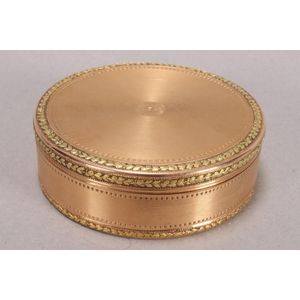18th Century Two-Toned Gold Powder Box with Ivory Case
Fine 18th century two toned gold powder box and cover, with ivory case, c.1780, in 22ct, probably Geneva, of cylindrical form, decorated with central floral roundel, with fine engine turned surrounds in rose gold to cover and base, with a leaf and floral border in yellow gold to sides and rims, total weight 108gm, diameter 8 cm, the whole set within a cylindrical ivory box decorated with classical figures, flowers and instruments (2). Provenance: collection of the late Fredric Sinfield, Sydney NSW, 1938 - 2008
You must be a subscriber, and be logged in to view price and dealer details.
Subscribe Now to view actual auction price for this item
When you subscribe, you have the option of setting the currency in which to display prices to $Au, $US, $NZ or Stg.
This item has been sold, and the description, image and price are for reference purposes only.
- Ivory - Ivory is a hard white material that comes from the tusks of elephants, mammoth, walrus and boar, or from the teeth of hippopotamus and whales. The ivory from the African elephant is the most prized source of ivory. Although the mammoth is extinct, tusks are still being unearthed in Russia and offered for sale.
Ivory has been used since the earliest times as a material for sculpture of small items, both in Europe and the east, principally China and Japan.
In Asia ivory has been carved for netsuke, seals, okimono, card cases, fan supports, animals and other figures and even as carved tusks.
In the last 200 years in Europe ivory has been used to carve figures, for elaborate tankards, snuff boxes, cane handles, embroidery and sewing accessories, in jewellery and as inlay on furniture. Its more practical uses include being used for billiard balls, buttons, and a veneers on the top of piano keys.
The use and trade of elephant ivory have become controversial because they have contributed to Due to the decline in elephant populations because of the trade in ivory, the Asian elephant was placed on Appendix One of the Convention on International Trade in Endangered Species (CITES), in 1975, and in January 1990, the African elephant was similarly listed. Under Appendix One, international trade in Asian or African elephant ivory between member countries is forbidden. Unlike trade in elephant tusks, trade in mammoth tusks is legal.
Since the invention of plastics, there have been many attempts to create an artificial ivory - Roundel - A roundel is a circular disk, medallion or border on a plate or dish, on an object of furniture. A plate or dish will often have a central circular bordered decoration, termed a roundel. In furniture the word is often used instead of the word 'patera' to describe a turned circular decoration. In recent times use of the word has expanded to encompass any circular area on an object.
- Engine Turned - Engine turning is a decorative technique used on metal surfaces to create intricate curving or geometric pattern. The process involves cutting a series of lines into the surface of the metal using a rose engine or decoration lathe which rotates the metal as it cuts, allowing the operator to create a repeating pattern that covers the entire surface. The resulting surface has a shimmering, reflective quality that is often described as "engine turned." Where an engine turned item has been enamelled, the term used to describe the decoration is usually guilloche.
Engine turning was originally developed to decorate metal objects such as firearms, scientific instruments, and other metal objects that required precise and elegant design.
This item has been included into following indexes:
-
boxes, material or decoration
- gold boxes 94
- ivory boxes 89
